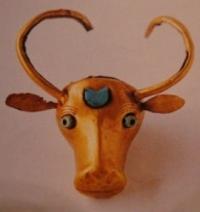You are here
Khurmuzfarra caravanserai.

Heritage tourism in Turkmenistan.
“Then it became a north-eastern outpost of the Sassanian one and enjoyed an era of religious tolerance, with Budhists, Zoroastrians and Neoastrian Christians cohabiting peacefully. As Baghdad’s power waned Merv’s waxed. In 1037 she switched her allegiance from the Caliphs to the Seljuk Turks and became the adopted capital of their great viceroy Sultan Sanjar, who shifted the city westwards and gave it new defenses and a giant mausoleum in his own memory”
Religious tourism in Turkmenistan.
The ruins of Khurmuzfarra are situated approximately 31 km to the north of Merv. This town served the important basic station on the trade route from Merv to Khorezm for centuries. The caravanserai of Khurmuzfarra (IX - X c.c.), built of mud brick, had the unique lay-out. It was very vast.
Here there were only 8 rooms, all other space was occupied by three-, two- and one-row stoia (a long gallery-portico surrounding the yard from the west, south and east). Each section of the stoia was covered with a dome based on massive supporting arches over-thrown between the pillars of large section (1.3 x 1.3 m). Initially, there were 57 such domes, after rebuilding of caravanserai - 77.
The rooms were destined for people, dome-arched porticos served for luggage and for animals during bad weather. The main entrance, shaped by two semicircular towers, was located from the south. There were also ancillary entrances-wicket-gates in the northern and eastern walls.
The first fragmentary references about Khurmuzfarra appear among several Muslim authors describing the history of the conquest of Khorasan by Arabs; then some geographic works and dictionaries of the X c. (Istakhri and Makdisi) and of succeeding centuries up to the XV c. (Idrisi, Samani - XII c., Yakut - XIII c., Khamdallah Kazvini - XIV c. and Hafizi Abru - XV c.) contain some information of the town. In addition to Khurmuzfarra there are found other names of this point such as Musfari, Masfara, Safari or Safri, Uly Kishman.
In 1946 the Ashgabat historian and ethnographer G.I.Karpov indentified first the medieval Khurmuzfarra with the ruins of Uly Kishman site. In the archaeological respect Uly Kishman was explored by the YuTake in the 1946, 1950 and the 1960-s.
Khurmuzfarra caravanserai is very original in architectural respect and does not resemble the Middle Eastern caravanserais of that time. This was an inn for caravans passed to Khorezm through the desert, a large trading station where enterprising merchants had often made wholesale dealings.
Therefore, it has a little number of living khujras and many sheds for animals and packages. Before the XI c. the functions of caravanserais were implemented by an ordinary dwelling keshk, surrounded by with well-defended yard.
Caravanserai in Khurmuzfarra shows a different lay out scheme of inn which was finally formed in Khorasan by the end of the XI c. The plan of these rectangular or square but almost.
Authority:
http://whc.unesco.org







